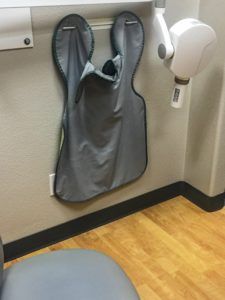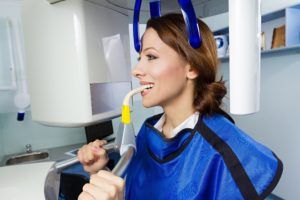A cone beam computed tomography (CBCT) scan, also known as Digital Volumetric Tomography (DVT), is the latest in dental x-ray technology. CBCT scans are able to capture and produce 3-D images of the teeth and jaws that show more detailed anatomy including soft tissues and nerve pathways. The increased anatomical detail allows for more accurate diagnostics and better treatment planning. When compared to a normal 2-D image, images obtained through CBCT technology are more clear and show more accurate information regarding bone height and width, contour, and jawbone thickness. For this reason, CBCT scans are an important part of any dental office.
CBCT scanners are usually composed of a chair that you sit in. While you sit, an arm containing an x-ray source and detector will rotate around your head to obtain the image. As the arm rotates, it will take several images from a variety of angles and then compile the multiple images into a single, 3-D image.
Did You Know?
With each rotation of the CBCT arm, approximately 150 and 600 high resolution 2-D images are captured. The final 3-D image is a compilation of these multiple images and shows your teeth, gums, soft tissues, and nerve pathways.
Frequently Asked Questions:
Do I need a CBCT scan?
You may need a CBCT scan if you are having certain types of dental procedures performed. It is most commonly used in the planning phase for orthodontic treatment, however it can also be used for additional reasons such as:
- Reconstructive surgery
- Oral and maxillofacial surgery
- The placement of dental implants
- Diagnosing temporomandibular joint disorder
- Planning for the extraction of impacted wisdom teeth
- Planning for a root canal
- To evaluate the jaw, sinuses, nerve canals, and nasal cavity
- To determine bone structure and amount of bone mass
- To diagnose pain
- To detect, measure, or treat jaw tumors
It is important to note that CBCT scans are generally only used if it is believed that a 2-D dental digital x-ray will not provide enough diagnostic information. This basically means that CBCT scans are generally only used when certain procedures are performed to ensure proper diagnosis and treatment planning.
What is the difference between a 2-D dental x-ray and a 3-D CBCT scan?
2-dimensional dental x-rays images essential take a 3-dimensional face and compress it into a 2-D image. By losing a dimension, the resulting image lacks magnification, is often distorted, and has overlapping or superimposed structures. Simply stated, a 2-D image does not show the anatomy as it actually exists.
A 3-D CBCT scan, on the other hand, essentially reproduces almost the exact anatomy on the screen. It shows far more detail in terms of volume and the spatial relationships of structures. As mentioned before, it also shows soft tissues and nerves. Overall, a CBCT image offers more information for the planning of certain treatments.
What are the benefits of a CBCT scan?
CBCT scans offer many benefits, including:
- They are painless, fast, and non-invasive
- Soft tissue and bone can both be evaluated in a single image
- Radiation does not remain in your body after the scan
- There are no immediate side effects
- They allow for better treatment planning and treatment outcomes
Do I need to complete any special preparations before my CBCT scan?

CBCT scans do not require any special preparations. However, before the scan you will be asked to remove any metal objects such as jewelry, eyeglasses, hairpins, or hearing aids because they may interfere with the scan.
Additionally, if you believe you may be pregnant, you will need to inform your dentist or person performing the x-ray. Regardless of whether you are pregnant or not, you will likely be given a lead apron to wear as an additional precaution.
What can I expect when undergoing a CBCT scan?

During a CBCT scan, you will be asked to sit in the chair attached to the machine. Your face will be positioned so that the desired area is the focal point of the scan. To keep you still, you may be asked to rest your head against something or you may have stabilizers placed by your ears to keep your head from turning.
The scan will only last about 20-40 seconds for a full mouth x-ray and about 10 seconds for a regional scan. During this time, the x-ray arm will slowly rotate around your head and it is important that you remain completely still. You will not experience any pain or discomfort during the procedure.
What can I expect after having a CBCT scan?
After your CBCT scan, you will be able to return to your usual activities once your appointment is over. There is no special guidelines you will need to follow and you can return to eating and drinking as usual.
Do CBCT scans use radiation?
Yes, CBCT scans do use radiation. However, they use less radiation than medical CT scans. Medical CT scans uses approximately 63-154 days of background radiation. Background radiation is the name given to the amount of radiation that exists at all times in the environment. CBCT scans, on the other hand, only use about 6-30 days of background radiation, which is far lower.
While radiation does pose a risk, the amount of radiation used is so low that the benefits of a CBCT scan definitely outweigh the risk. Radiation is a downside, yes, but the upside is that CBCT scans allow for better treatment outcomes and a decreased risk of treatment complications. Furthermore, the American Dental Association (ADA) and the FDA only recommend the use of CBCT scans when necessary, so if your dentist is ordering this scan it is because it is the best option. However, if you have concerns about the safety of CBCT scans, please feel free to discuss this with our dentists.
At Tulsa Precision Dental, your smile is our top priority. For a full range of dental services using the latest in dental technology, schedule a consultation with Tulsa, OK dentists Drs. Chris and Kristie Vinson today!



